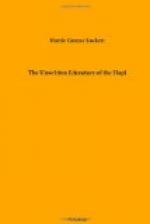“After this three days’ probation ... comes the wedding. Upon that day the mother cuts the bride’s front hair at the level of her chin and dresses the longer locks in two coils, which she must always wear in token that she is no longer a maiden. At the dawn of the fourth day, the relatives of both families assemble, each one bringing a small quantity of water in a vessel. The two mothers pound up roots of the yucca, used as soap, and prepare two bowls of foaming suds. The young man kneels before the bowl prepared by his future mother-in-law, and the bride before the bowl of the young man’s mother, and their heads are thoroughly washed and the relatives take part by pouring handsful of suds over the bowed heads of the couple. While this ceremonial ... goes on ... a great deal of jollity ensues. When the head-washing is over, the visitors rinse the hair of the couple with the water they have brought, and return home. Then the bridal couple take each a pinch of corn meal and leaving the house go silently to the eastern side of the mesa on which the pueblo of Oraibi stands. Holding the meal to their lips, they cast the meal toward the dawn, breathing a prayer for a long and prosperous life, and return to the house, husband and wife.
“The ceremony over, the mother of the bride (Note: All other authorities say groom, H.G.L.) builds a fire under the baking stone, while the daughter prepares the batter and begins to bake a large quantity of paper bread.... The wedding breakfast follows closely on the heels of the wedding ceremony and the father of the young man must run through the pueblo with a bag of cotton, handsful of which he gives to the relatives and friends, who pick out the seeds and return the cotton to him. This cotton is for the wedding blankets and sash which are to be the trousseau of the bride....
“A few days later the crier announces the time for the spinning of the cotton for the bride’s blanket. This takes place in the kivas, where usually all the weaving is done by the men, and with jollity and many a story the task is soon finished. The spun cotton is handed over to the bridegroom as a contribution from the village, to be paid for like everything else Hopi, by a sumptuous feast, which has been prepared by the women for the spinners. Perhaps ten sage-brush-fed sheep and goats, tough beyond reason, are being softened in a stew, consisting mainly of corn; stacks of paper bread have been baked, various other dishes have been concocted, and all is ready when the crier calls in the hungry multitude....
“With the spun cotton, serious work begins for the bridegroom and his male relatives, lasting several weeks. A large white blanket ... and a smaller one must be woven and a reed mat in which the blankets are to be rolled. A white sash with long fringe and a pair of mocassins, each having half a deerskin for leggings, like those worn by the women of the Rio Grande pueblos, complete the costume. The blankets must have elaborate tassels at the four corners. (Note: Representing rain falling from the white cloud blanket. H.G.L.)




